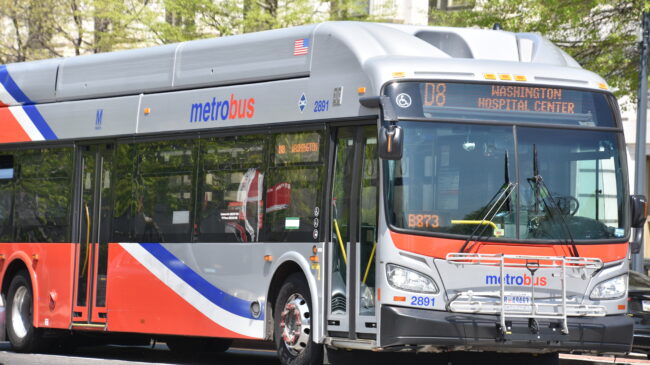Last month, the Washington Metropolitan Area Transportation Authority (WMATA) released the results of its four-year bus system redesign. The agency envisions 100 routes with 20-minute frequencies or better, with many routes having 12-minute headways. This does not include many other low-frequency routes. The plan would create 20% more bus routes that are competitive with driving, and WMATA estimates that this could lead to 10% more total trips. WMATA created this handy trip planner for riders to compare their old and new bus routes.
The concept of a bus system redesign makes sense. Since the last bus system redesign in 1971, the Washington, D.C.-region’s development patterns have changed, and bus routes have been altered in a piecemeal fashion since, creating a less-than-ideal operating map today.
Adjusting bus routes is a difficult, politically fraught ordeal that can be derailed when there isn’t a good explanation of the goals. One of the biggest challenges is communicating accurate information to political leaders and riders. WMATA deserves credit for developing innovative web tools to help explain its proposed changes. However, the website and numerous virtual meetings being held may not reach everyone. WMATA’s transit-dependent riders, those who don’t own cars and rely on transit, especially older people, may not have easy web access and online tools aren’t always a good substitute for public meetings.
Unfortunately, that’s where the praise for WMATA’s efforts ends. Rather than emulating the successful bus system redesign implemented in Houston, which used minimal additional funding—a 5%-to-10% increase—to help grow bus ridership by up to 40%, the WMATA plan seems to be a misguided empire-building exercise that will require substantial additional funding. The agency seems to be adding bus services designed for a previous era when a higher percentage of commuters used transit and residential- and employment-densities were much higher.
WMATA did not include all of the region’s counties, such as Loudoun County and Prince William County, Virginia, or Frederick County, Maryland, in its redesign process or its results. Those counties are located in the Washington, D.C. region and have their own transit service. If this is a regional plan, there should be more regional coordination. Loudoun’s omission is especially mystifying given that WMATA Metrorail’s Silver Line operates in that county today. Some riders use only rail or bus, but there still needs to be some coordination between the modes and agencies.
In fact, there does not appear much coordination amongst any of the transit agencies. When WMATA expands bus service into a given jurisdiction, there is no explanation whether the county operating existing bus service will maintain or discontinue its routes. Most county agencies operate service more cheaply than WMATA, so it’s unclear why WMATA should expand instead of the county’s own provider. It is also unclear how the regional WMATA service will fit with the county’s local service. There doesn’t seem to be any major attempt to connect remote services operated by different counties.
One of WMATA’s big selling points of the redesign is more hours of service. Traditionally, transit has been focused on the peak commute periods. Yet, many bus riders commute outside peak times, so offering service on weekends and evenings is essential. But WMATA is going one step further by providing 24/7 service on approximately 20 routes, many of which are in the suburbs or exurbs, where little late-night ridership would be expected. A much better use of resources would be to partner with ride-hailing companies or taxis to provide transportation for the small number of overnight travelers in these areas.
One of the region’s most significant transit weaknesses is the service connecting suburban Maryland with suburban Virginia. Fairfax County, Virginia, and Montgomery County, Maryland, are the two largest, by population, jurisdictions. With the expected rebuild of the American Legion Bridge and new express toll lanes on I-495, WMATA could offer multiple bus routes. Instead, it provides one route connecting Tysons Corner with Bethesda via River Road. Other routes that could operate in the new express lanes might link Dunn-Loring, Fairfax, Rockville, and North Bethesda. For all of the new routes proposed, the lack of routes between the two largest counties is a missed opportunity.
Some of the proposed routes are also baffling. A proposed 24/7 bus route from Tysons Corner to Dulles Airport along the Dulles Toll Road almost entirely duplicates the heavy rail Silver Line, which operates for 20 hours daily. Why operate both? When the Silver Line was conceived, WMATA manipulated the required alternatives analysis to justify the need for heavy rail when it did not exist instead of a bus rapid transit alternative. Now, WMATA is creating a premium bus service to operate in the same corridor.
Finally, bus redesigns in places like Houston are intended to be revenue-neutral. Overall costs were limited to about 10% more than baseline spending. In contrast, WMATA assumes an increase of 35% over current spending. And that current spending includes federal pandemic stimulus funding, amounting to a 50% increase over the pre-pandemic baseline. Where will WMATA find the money? The document doesn’t say, but my guess is taxpayers.
For its bus system redesign, WMATA gets an ‘A’ for recognizing the need to modernize routes and the system, but an ‘F’ for execution. The agency would be better off developing a realistic and implementable plan with region-wide coordination that doesn’t require significant funding increases that could end up soaking taxpayers in the years to come.

